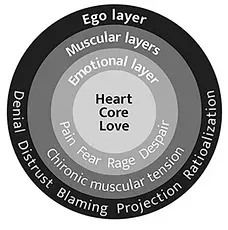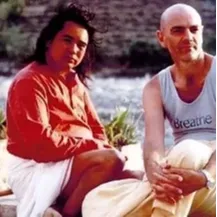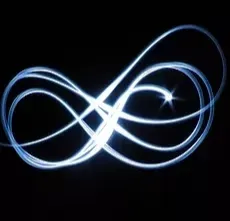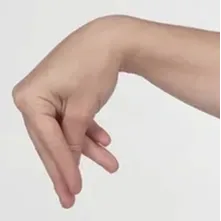WHAT IS BREATHWORK?
Connected Breathwork is a simple practice of breathing which can lead to insight and healing. It can lead to such profound benefits that have been described as "ten years worth of therapy in a single session". Currently gaining huge popularity around the world, breathwork comes in several styles including Rebirthing, Holotropic, and Wim Hof Method. It is one of the main practices of BreathYoga. Read on to learn what breathwork is, why people do it and how you can practice it.
In this article:
-
What is Breathwork?
-
Is Breathwork Just Hyperventilating?
-
What is Breathwork therapy?
-
Benefits of Breathwork
-
Types of Breathwork Approaches
-
How to Practice Breathwork
-
Nose Breathing Vs Mouth Breathing
-
Tetany During Breathwork
-
The Breathing Release
What is Breathwork Exactly?
“Breathwork” could refer to any conscious breathing practice including mindful breathing, yoga, tai chi, and qi gong. However, “breathwork” commonly refers to a specific practice of “Conscious Connected Breathwork” of which there are many approaches. The core technique itself is part of our human heritage and is found across cultures under different names over time.
Conscious Connected Breathwork is a circular breath technique. This means that inhalations are immediately followed by exhalations without pause. When maintained for upwards of an hour, Conscious Connected Breathwork brings on non-ordinary states of consciousness and can lead to profound experiences of healing.
Isn't Breathwork Just Hyperventilating? Is it Safe?
Breathwork rapidly but temporarily reduces CO2 and oxygen delivery to the tissues and suppresses activity in frontal cortex of the brain. In the blood, alkalinity increases and calcium decreases. Sensory and motor neurons begin to fire more rapidly, which can feel like tingling sensations and cramping.
These are the effects of hyperventilation, however hyperventilation usually denotes a loss of control whereas Conscious Connected Breathwork is done with intent. This makes the difference. Instead of a negative experience, breathwork is a practice which can be incredibly therapeutic.
Although it can initially feel intense, Connected Breathwork ultimately leads to good results. The temporary alterations of the body chemistry are not harmful to the body, and are in fact, shown to have positive physical benefits as well. Before attempting breathwork, you may want to check with your doctor if you have non-medicated high blood pressure or have been diagnosed with psychosis however. If so, breathwork can still be practiced but more gently and slowly, emphasizing awareness.
"Rebirthing is safer than going to kindergarten" - Leonard Orr
Breathwork Benefits
The spectrum of experiences with Breathwork range from physical sensations of pain or pleasure, the release of body blockages through heat or energy movement, and the release of pent up emotions (sadness, anger, etc.) There may be realizations about dysfunctional thought patterns or new insights, and deeply spiritual or energetic experiences. You may experience expanded consciousness, overwhelming feelings of peace and joy and even mystical revelation. Your experiences may vary every time.
Breathwork can bring about improvements in health, emotional wellbeing and appearance. Physical benefits include enhanced immune function, lowered stress and blood pressure, and improved cardiovascular health, including improved heart rate variability (HRV).
Mental and emotional benefits of breathwork begin with an unburdening of background tension, anxiety, grief, or depression and can aid in the release of trauma and PTSD. It will help you to heal emotional pain and process emotions taking you to a better place of increased clarity, wellbeing and happiness. Those who commit themselves to a course of Connected Breathwork and mentoring have been universally grateful and permanently changed.
Breathwork as Therapy
Our respiration patterns are changing constantly, from our very first breath to our last. When we feel calm, we breathe with serenity. When we feel anger, the breath changes. Our breathing changes automatically to reflect our thoughts and emotions. We might hold our inhalation during a particularly peak stressful moment or when we wish to suppress difficult emotions. We also respond similarly when we receive a phone call with bad news. It could be the stress of an accident, or from violence of some kind. It can be a habit of saying unkind words to ourselves over and over. Even the smallest of breath holds rapidly change blood chemistry, yielding instant emotional dissociation as well as the perception of control. There is a recurring patterns of high emotions > breath holding > muscles suddenly contracting = a ‘knot’ of tension, forged in an instant.

This automatic alteration in breath and dissociative knot of emotions can accumulate to become a morass of background fears, sadness and anger. We notice these knots cause “side-effects” such as a persistent experience of loneliness, anxiety or depression. but we don’t often know how to release them.
Connected Breathwork allows one or more of these knots of tensions to arise to the surface, be brought into consciousness, and then be released. It is a uniquely rapid way of clearing the knots out of our system. Even with one session we become clearer and lighter as people, and more in touch with who we really are. Connected Breathwork is a rapid means by which we can become aware of and release these knots, gain greater consciousness, insight and even bliss. It teaches mastery over both breath and mind.
Types of Breathwork Approaches

All schools of breathwork use a variation on the same technique of conscious, connected breathing. This method was first discovered or rediscovered in 1960 by Leonard Orr, an American who went on to form a breathwork school known as ‘Rebirthing Breathwork’.
Orr spontaneously began doing connected breathing and through this, would experience spontaneous regressions to his own birth memories. He came to understand that unprocessed, or repressed emotions condition us to react to events in fixed ways and have a physical impact on the body.
Rebirthing continues Orr’s Conscious Connected Breathwork by integrating psychological mentoring to reflect on our life story and offer affirmations that can change how we talk to ourselves. Rebirthing is typically done in a quiet and supportive one-on-one setting. Sessions take approximately two hours where the breath is coached but not strictly forced. Around the same time, Czech psychiatrist Stanislav Grof also discovered a method of conscious connected breathwork in an attempt to reproduce the effects of taking the psychedelic drug LSD. Grof's method came to be known as Holotropic Breathwork and is practiced in long sessions involving loud music and the creation of artistic mandalas after the session to integrate the experience.
How to Practice Conscious Connected Breathwork
Often it can be difficult to remain aware and maintain the breathing technique without outside guidance. Additionally, connected breathwork can bring up emotional experiences for which you may want or need assistance to help navigate. For these reasons, we recommend that you have guidance and support from a trained and experienced breath guide.
Leonard Orr, founder of Rebirthing Breathwork taught the following practice for people who do not have a breath coach with whom to work with. It is called '20 Connected Breaths':
Perform full inhalations into the upper chest, and then immediately let go of the breath with a passive exhalation. Do not hold or pause your breath. This sequence is '4 fast, 1 slow, 4 times'. As you inhale, the intent is to "receive." As you exhale, the intent is to "let go". As the name 'Connected Breathwork' suggests, try to maintain awareness of your breaths. Maintaining awareness may get more challenging the longer duration you maintain the practice.
Conscious, Connected and Continuous
Conscious Connected Breathwork can be practiced in short sessions or longer sessions. Longer sessions are performed to reach other-than-usual states of consciousness and shorter sessions are done for a quick refresh, or as a lead-in to breath holding. The key difference between shorter sessions and longer sessions is how the breath is kept continuous during longer sessions.
The infinity symbol models the continuity needed. The exhale is immediately followed by an inhale, and the exhale is immediately following a full inhale, without pause between them.

Continuity of the breathing is one of the most challenging aspects of an extended session of connected breathwork. This is one of the reasons it is recommended to have a breathwork guide to support you in staying conscious and continuous.
Nose Breathing Vs. Mouth Breathing
We should always be breathing through our noses in our day-to-day lives, during sleep and even when exercising. However, during the specific, conscious practice of Connected Breathwork, breathing through our mouths can be an accelerator for the experience.
Mouth breathing lowers carbon dioxide levels in the blood faster than nose breathing. As a result, mouth breathing tends to bring on a different state of consciousness faster and more intensely. The exhalation is accompanied with gentle intention to "let go". Letting go of stuck emotions, letting go of the past, letting go of grudges, letting go of disappointments, and so on. The inhalation is accompanied with the intention to "receive". Receiving teaching, higher forms of energy, inspiration, creativity, change, etc.

"Imagine a house that has not been cleaned in years. Nose breathing would be like dusting the window sills or polishing the silverware. You wouldn't start that way. First you'd sweep or even shovel out all the big heavy garbage. That's mouth breathing" - Dan Brule, Author "Just Breathe"
Tetany During Breathwork
Tetany is an involuntary, and sometimes uncomfortable or painful contraction or cramping of the muscles that may occur in the hands, feet, face or other parts of the body during breathwork. Tetany during breathwork doesn't happen to everyone or in every session. It is temporary and harmless. You may find it helpful to know that there is a medical explanation for this phenomenon as well as a psychological/energetic explanation.

From a biochemical point of view, the involuntary contraction of the muscles is due to either low calcium or low magnesium levels in the blood. This may be due to issues with the parathyroid or a lack of proper nutrition in the diet. It may also be due to the way that breathwork lowers CO2 levels, causing a rise in blood pH, which affects the binding of the calcium.
The likelihood of tetany during Connected Breathwork is raised by the great reduction in CO2 levels brought about by the practitioner using mouth breathing and forcing their exhalations outward. Therefore it may be be useful to return to the simple guidance of relaxed exhalations (as opposed to forcing the air out) and even switching to nose breathing.
However, if tetany is occurring without hyperventilation, then we can look to what it may represent psycho-somatically. Tetany could be a sign that something needs to be let go. It could be old emotional blocks, thought patterns or otherwise stuck energy.

"What seems to happen is that faster breathing creates a biochemical situation in the body that facilitates emergence of old emotional and physical tensions [including tetany] associated with unresolved psychological and physical traumas… this situation actually represents a unique opportunity for healing. What emerges under these circumstances is unconscious material with strong emotional charge that is most ready for processing" - Stanislov Grof
The Breathing Release
The "breathing release" is a stage in the practice of Conscious Connected Breathwork where the breathing suddenly becomes liberated and there is an experience of breathing with total ease, pleasure and joy. Often it is described as the sensation of "being breathed" by the breath, or by the universe itself. This moment can also be observed from the outside. Only once one has experienced the breathing release does one realize how restricted their breath was before the release.

"The Breathing Release is the main event in learning to breathe energy as well as air. It liberates the breathing mechanism. Nobody knows when it will happen, it cannot be induced. It happens when the person feels safe enough" - Leonard Orr
Experience Breathwork
If you feel drawn to experience breathwork, it is an experience which you ideally should have in person, preferably in a one-to-one session with someone you feel you can trust in an environment which feels safe and allows you to fully relax into. We offer one-to-one breathwork sessions in Kobe, Japan or by arrangement we can travel to you. Contact me here to learn more!
Learn Resonance Awakening
Join our free course on conscious breathing and guided journaling. Learn everything you need to begin a transformative, 30-day practice in under one hour. Comes with downloadable resources, lifetime access.
Start Now- It's FREE
